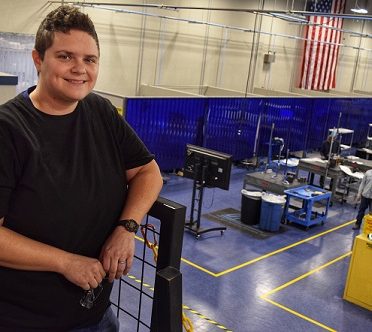(HUTTO, Texas) – Lauren Caprio got her first welding job in 2016 shortly after graduating with a certificate from the Welding Technology program at Texas State Technical College in Williamson County.
Caprio, 33, of Pflugerville is a level III ultra-high-purity welder at Dynamic Manufacturing Solutions in Austin, where she works in a humidity-controlled clean room with employees wearing white protective gear to do tungsten inert gas welding and orbital welding. The controlled climate means employees can work with very pure materials to ensure quality for the biomedical, pharmaceutical and semiconductor industries.
“It is super-high accuracy,” Caprio said. “Everything has to be really exact. It you are detail-oriented, it is satisfying.”
The longer Caprio has worked at the company, the more complex her training has become.
“I know there is a ton of work for me here,” she said. “I feel really appreciated.”
Seventy percent of what the company has produced in the last 12 months has been exported overseas.
“We are passionate about building things in the United States,” said Robb Misso, the company’s chief executive officer. “Our ability to grow is limited to hiring good-quality welders, period.”
The company primarily looks for welding job candidates at TSTC and other two-year institutions.
“Building relationships with employers is essential to the success of our graduates and the TSTC mission,” said Edgar Padilla, provost of TSTC in Williamson County.
Misso said students learning about welding should think more high-tech as the industry evolves into automation and robotics. Parents and school counselors can play a role in encouraging students to pursue welding.
“We need a skilled workforce to do the assembly,” Misso said. “More TIG (tungsten inert gas), less MIG (metal inert gas welding).”
Misso said China, Vietnam and Malaysia are some of the nations he keeps an eye on regarding their technology. He said these countries have lower land costs, but the work quality does not compare to what is created in the U.S.
“For us to bring the jobs back to the U.S., we have to use technology to have a step up on other parts of the world,” Misso said.
Welding jobs in the United States are projected to grow to more than 427,000 through 2026, according to the U.S. Bureau of Labor Statistics. And, welding factors into industries such as aerospace, construction and manufacturing that the Texas Workforce Commission considers as being in-demand and high-earning in the state.
“Welding is an interesting science in that the physics of welding will never change, but the methods of teaching and technology available to do so will continue at a rapid pace,” Padilla said.
For more information on Texas State Technical College, go to tstc.edu.
